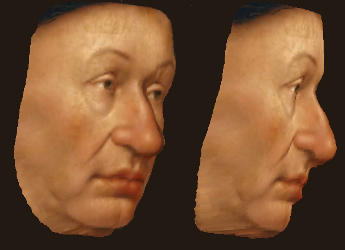
MHDB Article ID: FR20210112
MHDB Article date: 12 January 2021
MHDB Article Author(s): Staff
3D Facial Reconstruction Feature
Reconstructing 3D models of historical figures is now feasible using artificial intelligence combined with modern video cards in desktop computers.
Some models have acheived a considerable degree of realism, but most such models in recent years have focused on either ancient or post-15th century persons,
with relatively few models of medieval people despite the existence of many realistic portraits, especially in the late Middle Ages.
This project will therefore attempt to reproduce medieval kings, dukes, and other personnages for whom surviving paintings or sculptures exist.
Artifical intelligence methods can now take a painting and extrapolate the contours of the face as well as a photorealistic image of the skin, hair, etc.
This process usually requires a lot of human guidance and much patience, sometimes taking months, but nonetheless it often leads to impressive results. A full
3D model allows not only reconstruction of historical persons but also animation of the entire body by connecting the mesh to a "skeletal" frame which can then
be used to deform the mesh in a realistic manner to allow the figure to walk and engage in other activities.
Results depends on many factors, especially the degree of detail in the surviving paintings or sculptures. Some details need to be extrapolated based on
written sources, or using AI or human judgement to reconstruct a side of the face that isn't visible.
The image below shows an early prototype, using a partial 3D mesh for the face of King Charles VII of France, based on a portrait by Jehan Fouquet in the 1450s:
There are a number of portraits of Charles VII, some of which are idealized; but the painting by Fouquet is believed to be accurate since it clearly isn't
idealized (the large nose, sleepy eyelids, dour expression, etc, are unlikely to represent an attempt to make him more handsome than he was), and it closely
resembles another warts-and-all painting of him as well as resembling other members of the Royal family.
On the left is the original painting; the other images show the 3D model viewed from several angles. After completing the face and neck, clothing will be
added and the face will be animated - blinking eyes, movement of the mouth, eyebrows, and so on.

|